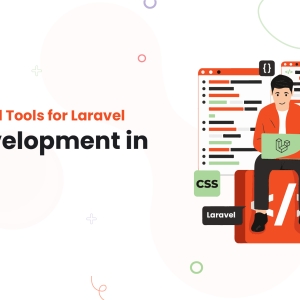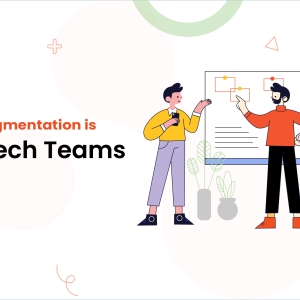Introduction
In the fast paced world of web development, the ability to adapt faster and efficiently can set a project apart from its competition. This is majorly true when you are working with the MEAN Stack, i.e. MongoDB, Express.js, Angular.js and Node.js which are a popular set of technologies well known for creating a dynamic and scalable web application. However, the true potential of these tools is unlocked only when it is integrated into a flexible architecture.
A flexible architecture is important for any business that anticipates growth and changes in the technology or user demand. Moreover, it supports scaling up or down smoothly by integrating new features without any downtime, thus managing performance under varying loads.
For a MEAN developer this means lesser time spent on costly redesigns and more focus on innovation and improvement.
In this detailed guide, we’ll talk about what we need to build a flexible MEAN stack architecture. No matter if an organization is looking to hire MEAN stack developers or they are doing it on their own, understanding how to structure your projects for flexibility can lead to more powerful, future-proof applications.
We'll break down the complexities of the MEAN stack, provide practical steps for setup, and dive deep into strategies for modular design, effective data management, and scalable solutions. Get ready to transform the way you develop web applications by embracing flexibility at the core of your projects.
But before we jump into the technicalities let us understand what is MEAN Stack?
What is the MEAN Stack?
MEAN Stack development is a combination of four efficient technologies, i.e. MongoDBe, Express.j, Angular.js and Node.js. Each of the above technologies plays a vital role in web development, where MongoDB acts as the database, Express.js handles the backend, Angular.js manages the frontend and Node.js serves as the runtime environment.
This combination is popular for developing modern, dynamic web applications. But, building these applications isn't just about using these technologies—it's about creating a system that can adapt and grow. That's where flexible architectures come in.
Before we dig into learning the process and the steps to be used let us first understand why does Flexibility matter in a MEAN Stack Development
Why Does Flexibility Matters?
In the fast paced digital era, businesses should look forward to adapting to the changing needs quickly. A flexible architecture would allow applications to scale, maintain performance and integrate new features without a complete overhaul.
When you hire MEAN stack developers, they would use this practice to build a system that can handle an increased traffic, larger data loads and an evolving business requirement efficiently.
Now, let’s understand the Process of building a Flexible MEAN Stack Architecture
Let’s benign the first point, i.e. What makes an Architecture Flexible
8-Step Process of a Building a Flexible Architecture
What Makes an Architecture Flexible?
A flexible architecture is scalable, maintainable and modular. It can grow as needed without wanting to make any significant changes in its core structure. It is quite easy to maintain because its components are well-organized and loosely coupled. Moreover, it reduces the complexity involved in adding or updating the features that are important for a continuous development and deployment.
What are the few benefits of MEAN Stack Projects?
For MEAN stack projects, flexibility means being able to:
- Scale up the application when the user demand grows
- Update the technology stack with minimal disruption
- Develop and deploy new features quickly.
Now, let’s understand how we can set up a MEAN Stack Development environment
How can we Setup a MEAN Stack Environment
Before starting to develop MEAN Stack, you need to set up the environment properly. This would include an installation of MongoDB, Node.js and Angular CLI. Each of these component has an official documentation that guide the developers through the complete installation process.
MongoDB: Download and install from MongoDB's official site.
Node.js: Download from the Node.js website.
Angular CLI: Install via npm (Node Package Manager) with npm install -g @angular/cli.
Now, let’s understand how you can design a Modular MEAN Stack Architecture
Designing a Modular MEAN Stack Architecture
Embracing Modularity
A modularity means breaking down an application functionality into smaller, interchangeable parts. Here each of the module handles a specific piece of application functionality and can operate independently of the others
How to implement Modularity in MEAN
In the MEAN Stack Development, modularities can be approached by
- Creating a separate module for each functionality in Angular.js
- Building a middleware and routing functionalities in Express.js to manage different business logic as separate modules.
- Using MongoDB collections to logically separate different data entities.
Now, let’s understand how can we build a Scalable System
How to Build a Scalable System
Scaling with MEAN
Scalability means the capacity of your application to handle a growing amount of work or its potential to accommodate growth. For any MEAN developer this could include:
- Using Node.js’s non-blocking I/O features to handle large numbers of simultaneous connections.
- Implementing load balancing to distribute client requests across multiple server instances.
- Consider a microservices architecture where different functionalities of the application are deployed as independent services.
Now further, let’s understand how you manage the Data effectively with MongoDB
Effective Data Management with MongoDB
MongoDB technology which is a NoSQL database excels in flexibility and ease of scale, making it an ideal option for projects that expect data growth and schema changes
Best Practices of Data management through MongoDB
- Use indexing to improve query performance.
- Organize data into collections and documents that reflect how data is accessed by the application.
Now further, let’s understand how you can create a Dynamic Frontend with Angular.
Creating Dynamic Frontend with Angular
An angular.js offers a few powerful features to build a dynamic, responsive UI. Moreover, it also supports a two way data binding, a real-time interaction and a dynamic content loading - which are important for modern web applications.
Now let’s understand about Node.js and Express.js the two two Backend frameworks of MEAN Stack Development
Backend Logic with Node.js and Express.js
Node.js and Express.js form the backbone of your application's server-side logic. Express.js simplifies the task of building server-side routes and handlers, making it easier to develop RESTful APIs that your Angular frontend can consume.
But what about the Quality, what role does Quality Assurance and testing play in achieving a Flexible architecture in any MEAN Stack Development
Quality Assurance and Testing
Ensuring an Application Integrity
Quality testing has become important when you are aiming to maintain the quality and performance of your application. By incorporating unit tests, integration tests and an end-to-end test using tools like Jasmine, Mocha or Protractor.
How can Acquaint Softtech help you in building a Flexible MEAN Stack Architecture
Acquaint Softtech is a company, we are based in India and we specialize in software development and IT staff augmentation services. We mainly use the Laravel framework to create websites and software that exactly match what our clients need. If your company operates remotely and you need to hire remote developers, we can help you find the right ones quickly. Our onboarding process is simple, allowing you to bring developers on board in just 48 hours.
What's even better? Our affordable pricing. We offer remote developer services at only $15 per hour. We're now expanding our skills to include MEAN Stack Development, and we invite you to hire MEAN stack developers from our skilled team to bring efficiency and innovation to your projects.
Now, quickly recap what we’ve learnt from this article.
Wrapping Up!
When you are building a flexible architecture with MEAN Stack it is more than just using the technologies, i.e., it is more about creating a system which is adaptable, scalable and also maintainable. As technologies and businesses evolve, so do your applications. With a solid foundation and a commitment towards flexibility helps you achieve a thriving MEAN stack development in this changing digital landscape.






